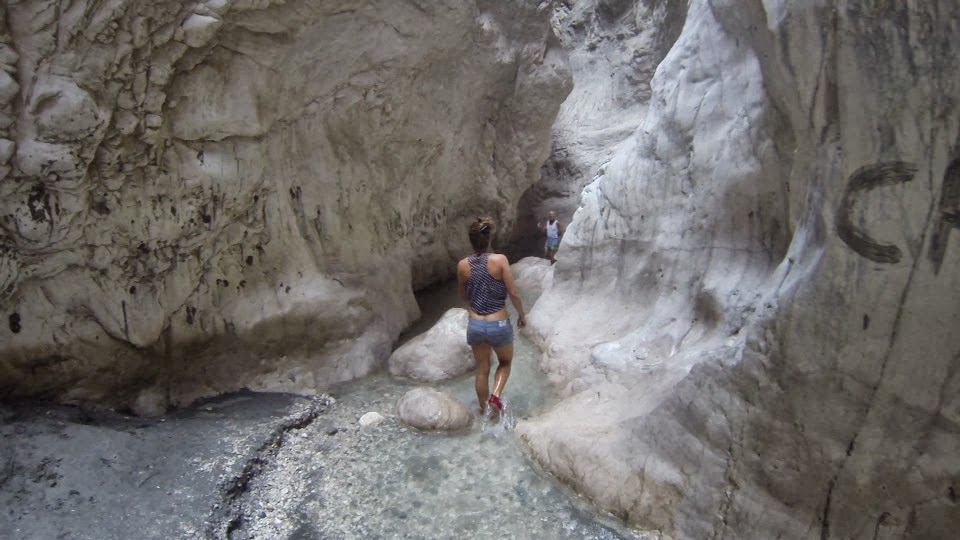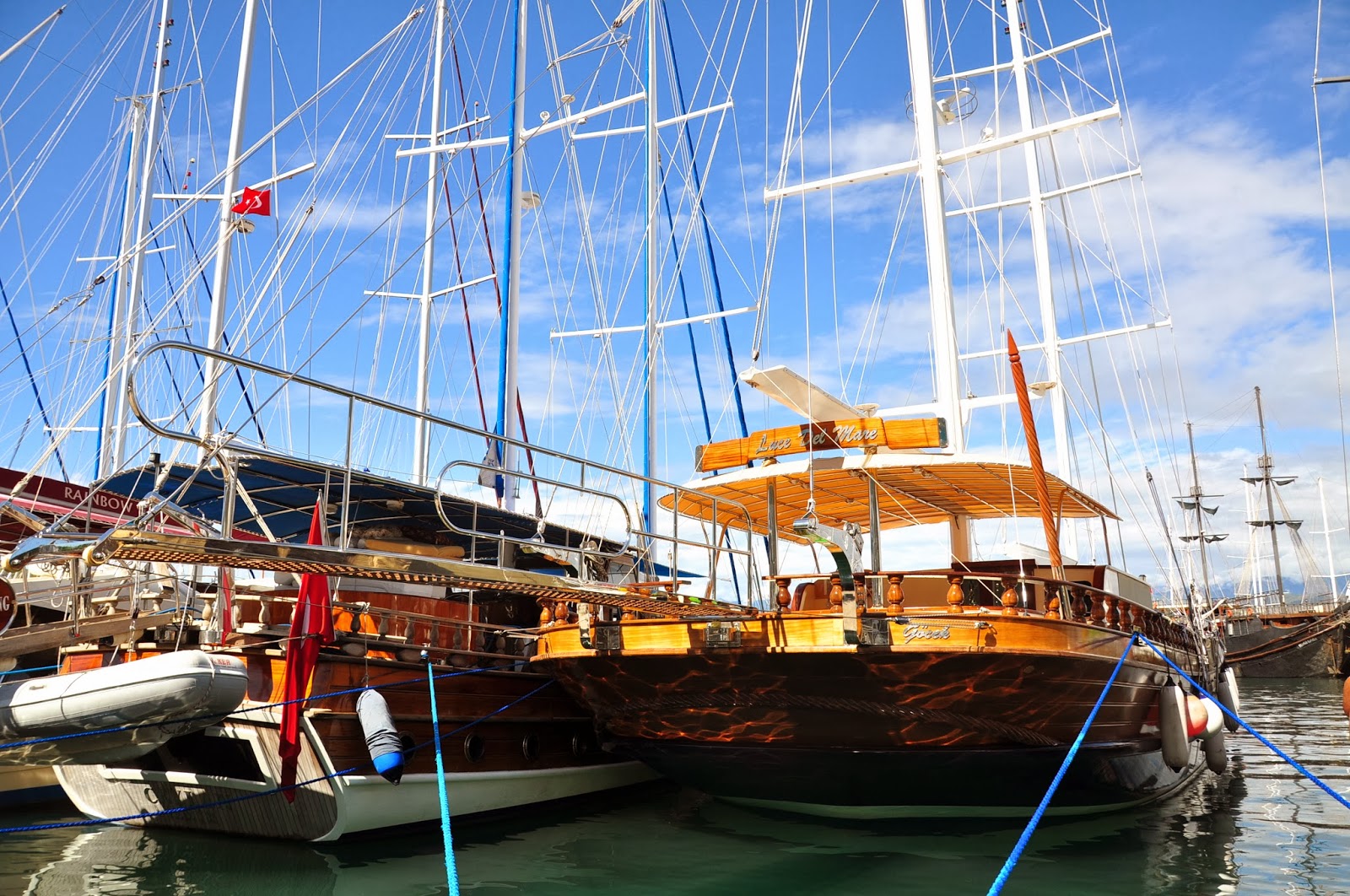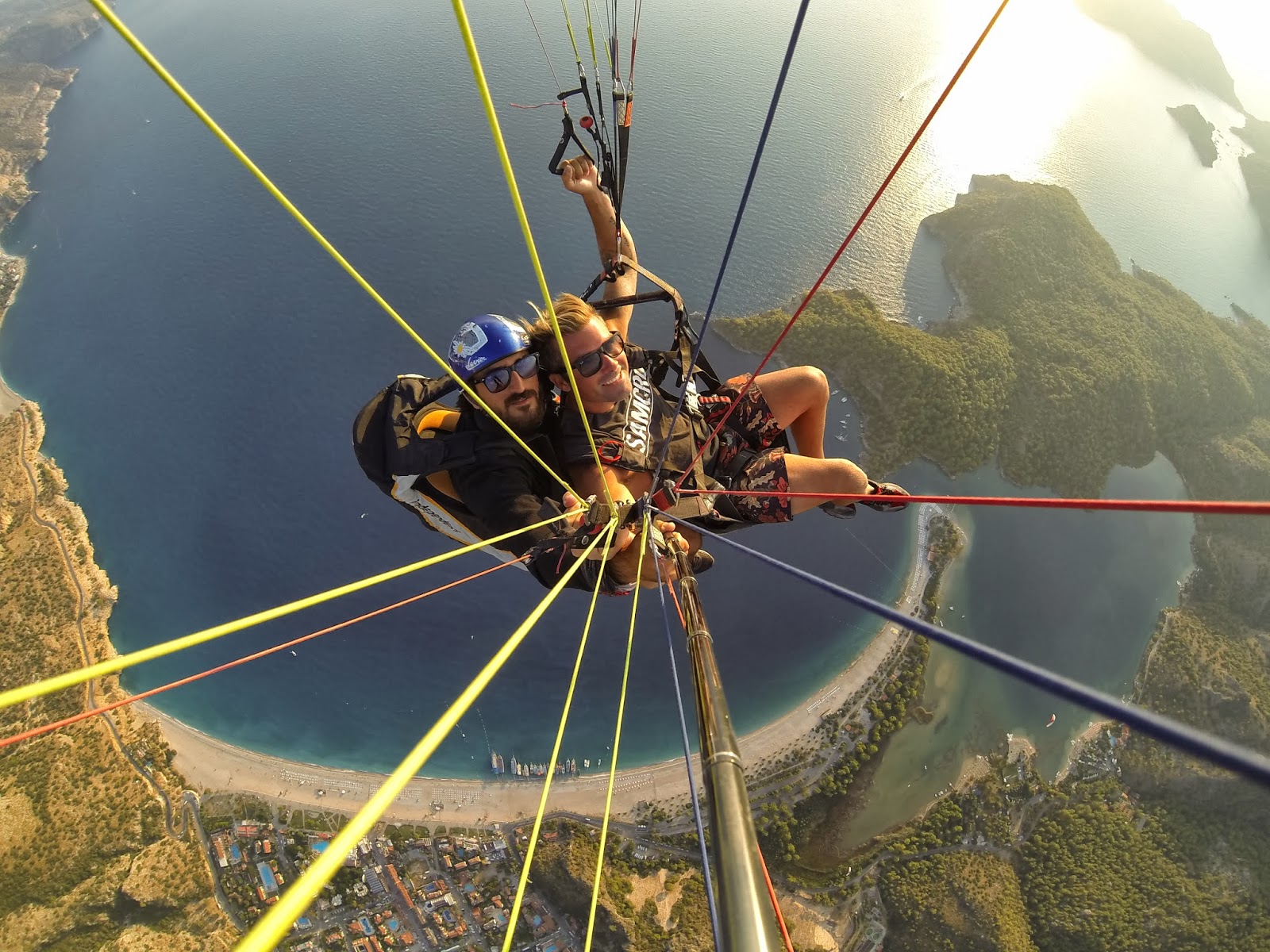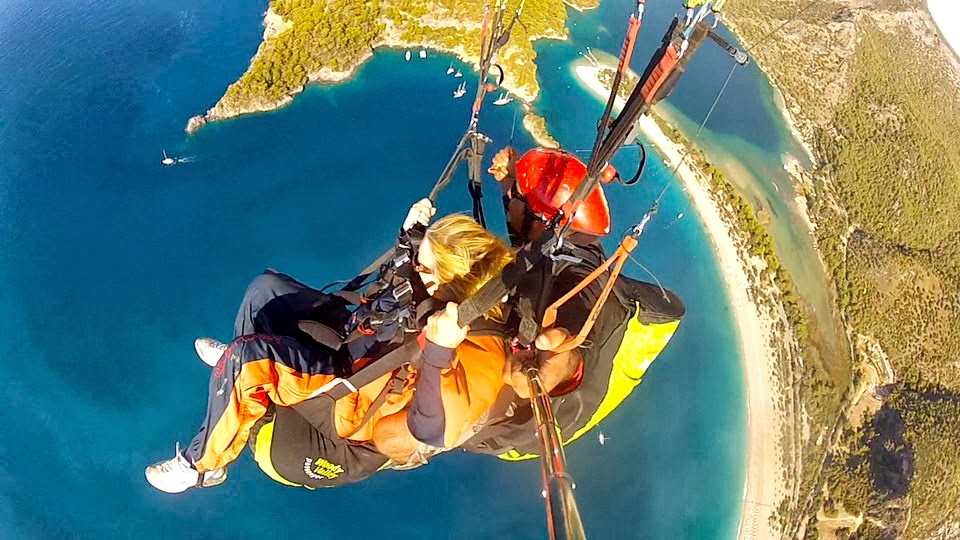After eight months, sadly today is Mike and my very last day aboard finally my darling for 2013. How time flies when you're having fun! Mum and dad will be in around Marmaris until early November, but the time is near for us to face the truth of reality. But before that time arrives... here are some Turkish treasures from the past few weeks:
Nearing the end of our last guests’ time onboard and with an incredible wealth of natural and historical attractions in an arm’s reach of Fethiye, we left the boat anchored, hiring a mini van for an expedition into the countryside! First stop was the mysterious ghost town of Levissi in Kayakoy. Apart from our party of six there was barely another soul in sight amid the expansive old township of crumbling stone houses. An eerie feeling washes over as you wander around; spellbound by a deserted hillside town that was once home to thousands.
In 1923 the Treaty of Lausanne was signed after the Turkish War of Independence, which resulted in a forced period of ethnic transition, where Muslim and Orthodox Greeks were re-settled
into each other’s regions and towns in Turkey and Greece. As there were often
less Muslim Greeks than Orthodox to be resettled in Turkey – and this
particular bunch didn’t care to live so far from the sea nor trek up and down
the steep streets – so towns during this time of transition were often
deserted. There is also evidence of abandoned
and defaced Christian churches amongst the ruins of the newly acquired Muslim dwellings – a solemn reminder in an Islamic country. Later, a
catastrophic earthquake in 1957 left most of the remaining homes in ruins. Villagers from the surrounding areas were
left to strip the ruins of useful wood and other materials to repair their own
damaged homes. The result is a ghostly old settlement that could pass for being
multiple centuries older.
Oludeniz is a destination nestled within a dramatic mountainous coast, most iconic for its long beach spit, backed by a protected lagoon. Like many major cities along this part of the coast such as Bodrum, Marmaris, Fethiye’s Calis district, Hisaronu and Kalkan, tourism development has been rampant over the past decade since Mike and I were last here. With condos and apartment blocks creeping all the way up the narrow valley, strings of hotels and restaurants selling English breakfasts or showing the latest soccer match. There is still a Turkish twist and more flavour in the old quarters of these towns, though I would hate to see what the next ten years could bring. And if you want to see what a developing tourist town should strive NEVER to become – take a drive through the ex-pat enclave of Hisaronu just south of Fethiye. Sad story.
That said, the striking beauty of Oludeniz still
dominates and is best viewed from the air to fully appreciate the lovely beach
spit and lagoon. We first drove to Oludeniz on our day exploring with John and
Tess. Perched in an open-air roof top bar, dad was captivated by the sheer
number of solo and tandem paragliders in the air at any given time. Easily
fifty colourful wings gliding in the thermals, spiraling tricks or skimming the
rooftops before touching down amongst the tourists walking the beach promenade.
We knew exactly what we’d be doing when we returned here on the boat a few days
later – and we had that same amount of time to work on mum!
If you’ve been following the blog for a while, you may have noticed
there's rarely a post that goes by without a pretty kitten or cat or two or three.
They breed like rabbits in Greece and Turkey! If there were ever a cat we had
thought twice about adopting as our boat cat, this would have been the one.
When she sauntered over to say hello, I crouched down for a pat and next thing
she had jumped onto my shoulders and camera bag ready to hitch a ride. What a
beauty!

The following morning we journeyed one hour inland to Saklikent Gorge – a remote natural wonder that we’d again visited previously and knew was worthy of a return. An 18-kilometer long gorge; runoff has carved a twisting, narrow path through the mountains over millennium, and at times barely the sunlight can creep through to the ravine below. The water level varies depending on the time of year and snowmelt, yet there are icy waters year round. Meander a short boardwalk in, but those wanting to venture much further must be prepared to get wet. First passing across a tricky flowing inlet and then onwards up the gorge. Arriving early and the first car in the car park, we had the entire gorge to ourselves until we’d reached the furthermost accessible point two kilometres in, and had turned around to head back. I had the same feeling ten years ago as I did today – that walking this gorge unguided would never be allowed in Australia and should there be a rainfall several kilometers upstream, a flash flood could sweep us all away in the blink of an eye. That vulnerable feeling that reminds you that you’re alive!
A string of entrepreneurial farmers on the road into Saklikent had
set up simple restaurants in front of their homes, heckling from the roadside
to attract passing traffic. Doing our part to patron a sweet old Turkish
husband and wife, we watched barefooted and cross-legged from our low-set table
as buyukanne Turk prepared from
scratch and cooked over a wood fired hot plate, the most authentic meat and
cheese gozleme I’ll likely ever eat!
Back in Fethiye, you don’t have far to look for ancient remnants that
are dated Before Christ – a Roman theatre excavation across the road from the
marina, a lone sarcophagi in the middle of a busy intersection and more Lycian
rock tombs carved into a cliff overlooking a now sprawling city.



Turkey offers some fun cultural tastes and treats that would be a shame not to partake in while here: squishy Turkish delights in every imaginable flavour; Turkish tea (cay) drank from petite glasses continually through the day; shaved meat doner kabaps; wafting aromas of the shisha water pipe – not to mention a close Turkish shave or ‘haman’ Turkish bath!
The Turkish bath or ‘hamam’ is a tradition that has evolved since Roman
times, with obvious remains of baths and their
heating systems evident amongst ancient ruins. Centuries old versions of the
baths are today operating in many of the atmospheric old quarters. Dome-roofed
steam rooms and at the centre a low round tiled or stone table where one’s body
is offered up for a vigorous soapy lather up and scrub down by a middle-aged,
loin clothed Turkish gent. Some hamams have plunge baths, but otherwise next
you’ll proceed to be soaked with bowls of cold water and the hair roughly
lathered before more drenching. Oil massage add-ons are available too – and at
the risk of losing the holiday tan via the top few layers of dead skin – I offered myself up at Fethiye’s hamam.
Mike’s manly pampering was next: the closest of close Turkish shaves
via cut-throat razor blade – twice over – and a whacking on the ears with an
open flame to banish the ear-lobe fuzz. Of course for Mike it all grows back in
a few days, but an entertaining activity to do as
the locals do! It’s obvious the Turkish male takes pride and effort in his
appearance, as there are barbershops everywhere and these man caves always
appear to be well patronized.
Wooden gulets (pronounced goo-let) are synonymous with Turkey. These
fine masterpieces of marine workmanship have been built here for centuries. Although
their design has evolved in recent decades to the current ‘Bodrum gulet’ style
that are specifically constructed for tourism – charter or private use cruising.
We’ve encountered literally hundreds of gulets touring the southwestern coast,
majority being three to seven day live aboard cruisers, or the smaller variety
as people-moving day-tripper boats. A three-day gulet trip between Fethyie and
Demre/Olympos was a highlight of Mike and my visit here in 2002. It’s obvious
their popularity has exploded in the past decade, in conjunction with a
burgeoning tourism trade. Close to our anchorage in Fethiye was number of sheds with no less than eleven gulets at different stages of
construction. Given our foot wear and safety gear was at the same standard of
the workers, they happily let us wander around and admire their handiwork.
Turkey’s remote and plunging coastlines are peppered with heavily
indented bays and lush protected anchorages. Should you make your way here one day, apart from cruising on your own
boat or a charter sailing yacht, joining
an extended gulet excursion is the next best option to
explore. And come in September! I would expect you’d melt into a sweaty puddle
if you arrived mid-summer.

After saying a final farewell in Fethiye to our dear guests of nine days, John and Tess, it was a short three-hour sail south to Oludeniz. The lagoon is off limits to boats and the beach is too deep until very close – or otherwise taken up with wooden day-tripper gulets and a long floating line that restricts any other boats approaching the eastern beach and shallows. Instead we anchored with a line ashore off the western cove – an uncomfortable rolly anchorage, especially for our neighbouring monohulls, but a convenient dinghy ride across to board the bus to paragliding!
Paragliding in Oludeniz has been a favoured past time and attraction
here for decades. Anyone with an adventurous spirit could not look up without
longing to experience the thrill of gliding like a bird. Dad, still sadly not
having flown his trike due to inability to secure training on floats, was
desperate to again feel the adrenalin rush of flight. Me having skydived before
and having always wished to tandem paraglide or hanglide; Mike hesitated but only
for a brief moment, but we were all surprised when at the last hour our
sixty-seven year old mum, who’s most daring activity to date was ziplining in
Whistler, agreed to join us on this once-in-a-lifetime adventure. A full family
affair!
The hour long mini van ride through Babadag National Park and up to
the 1,900 meter take off point was an adventure in itself! Within five minutes
of arrival Mike’s pilot Yusuf had his chute laid out, and with Mike attached,
had run off the mountainside disappearing into the glow of the setting sun. My
first attempt was aborted mid-run as the dying wind had failed to fill the
chute for a safe take off. A feeling of doubt started to creep in as mum, dad
and I were driven to another higher, shorter and rocky take off point in hope
of finding sufficient wind for uplift. Up at 2,000 meters was a magnificent
location to watch the sun set, along with the resident rooster, but thankfully
the pilots decided the lack of wind would not suffice, so back DOWN the 2,000
metre mountain by van we went!
Bright and early the following morning, the three of us joined three
other van loads of Gravity pilots and
guests, and numerous other companies jostling for position across the various available
take off points. In and out of the van searching for the best vantage point
given the wind direction – we eventually took off back where we had started the
day before. Fortunately all the anticipation and nerves had mostly dissipated
by that stage and we were all just stoked to be in the air. The 45-minute
descent overlooking Oludeniz and the lush Turkish coastline was blissful – we'll be sure to upload the Go Pro video edit as soon as we can access a decent internet service. An insane experience to share together and I still can’t believe mum joined
us, she's a rock star!
NOTE: Photos are courtesy of our
awesome pilots at Gravity Paragliding: www.flygravity.com
Meandering south down the coast from Oludeniz, one lunch stop was
anchored off famous Butterfly Valley: a deep, laidback valley amongst the
mountains that has largely avoided development. Apart from the overcrowded day-tripper gulets
that dump boat loads of people here every few hours (nowhere is safe really) –
there are simple huts to sleep in or free beach camping where the opportunity
still exists to stay the night and savour the original tranquility.
The ocean swell was not favourable, so we sailed past the hippy peace-seeking commune of Kabak. I was disappointed; as this was somewhere I was keen to see before it too, was too late. Camouflaged in the hillside and only accessible on foot or by tractor, Kabak has replaced the now overcrowded and overcooked tree-house village of nearby Olympos. Olympos, at the time, was a unique destination that brings back fond memories of our visit in 2002. So should Turkey be on your list and you seek out-of-the-way gems, I can only recommend via second-hand word of mouth, but head to Kabak!
Lazy nights were spent anchored off modern Kalkan and charming Kas (pronounced Kash). Yet the crown jewel
for this entire region has to be Kekova Roads and the unspoiled hillside
community of Kalekoy. A few hours’ sail south of Kas, Kekova Roads and its
protected islands and natural harbours create a stellar mini cruising ground.
This would also be finally my darling’s
southern most turnaround point on Turkey’s Mediterranean coast. Kalekoy is incredibly
special and treasured, in that one of the country’s most wealthy families, who
also happens to own a discrete mansion overlooking the village, has basically
paid the township off not to develop.
Accessible only by boat, Kalekoy was built on the ancient city of Simena and is
overlooked by the ruins of a superb Crusader fortress. There are literally
dozens of Lycian sarcophagus (above ground burial tombs) littered in the
surrounding fields, and the foundations of a sunken village can be viewed along
the foreshore of the island directly opposite.
Townships nearby to Kalekoy have boomed, becoming a step-off service
point for day-trippers travelling from Kalkan, Kas and Demre. Blasting
narration in multiple languages, we watched a steady stream of packed tourist
boats trolling the waterway past Kalekoy and its castle. Fortunately only one
in twenty day-tripper or gulet boats would actually stop and land. Enjoying
quiet sunset beers on the jetty fronting one of four pension accommodations, we
must’ve been only a handful of visitors in the town itself. We commented to the
pension owner how none of the passing tourist boats stopped in the village. He
smiled and replied "we like it that way." And that’s coming from a tourism
business operator. Seeing the hasty influx of somewhat demanding package
tourists and development in towns to the north, the locals here are fully aware
they are fortunate to retain their solitude and preserve their rare piece of
traditional Turkey. As night fell, we felt privileged to
be the lone visiting yacht at anchor, with twinkling village lights and the only
sounds being voices of the locals and a few chickens across the bay. And even
more so as the most solemn and purely delivered Islamic call to prayer echoed in the evening air around us – these are the
rare moments and places that will stay with you for life!




Knowing that the further south we sailed would result in a longer
slog north against the prevailing wind back toward Marmaris, we opted for an
overnight road trip to explore a little further around the southwestern coast.
Firstly thanks must go to our driver Mike for tackling the hectic roads and
traffic! With a population just under a million, Antalya is one of the largest cities
in southern Turkey; and Kalceici meaning ‘within the castle’ is its enchanting
old Ottoman quarter. Surrounded by Antalya’s modern buildings and high rises,
this walled hamlet faces out toward the glassy azure Mediterranean and dramatic
mountains surrounding the city that are littered with remarkable ancient ruins.
Our first night sleeping on land in seven months (wowza!) was at the charming
Atelya Art Hotel in the historic Kalceici
district. Ottoman flavours, antique furniture, dark wooden beams and
staircases, a sun drenched courtyard, original artwork by the owner on display
and the hotel’s location nestled deep in Antalya’s old quarter – it was a
delectable taste of Turkish style!




Turkish ruins are mostly from the Roman or Lycian eras and are
intriguing as they often lie as they have fallen, sometimes excavated though
not reconstructed, wild and overgrown where you can wander between columns and
heavy stone of the once incomprehensibly grandeur structures.
Along the road between Antalya and Kas there were more ruins than we
care to count or had time to visit. We chose to detour to the ancient Lycian seaside
cities of Phaselis and Olympos that dated back to the seventh and second
centuries BC respectively. Once important trading posts right through until the
Middle Ages, ancient Olympos in particular now lies in heavy and haunting overgrowth.
Thanks to a low-pressure system
building north of Rhodes in Greece – pulling with it all the wind and weather –
we took advantage of a rare day of solid southerly winds to sail north again
towards our final destination of Marmaris. Albeit threatening skies and
messy steel grey oceans, we sailed a long seven-hour dash north back up the
exposed coast. Returning first to Fethiye for a few more nights, where those
grey skies inevitably opened up to an amazing display of lightning and
thunderstorms (always fun when you are living under a 20-foot steel mast)! And brought
with it the first real rain shower we’d witnessed in THREE months. Cue full
boat wash down! As I've said before, if you want a holiday with guaranteed sunshine – look
no further than a summer in the Mediterranean!
A final rendezvous with our old travelling buddy boat Dominos was rafted up in a sweet
anchorage amongst Yassica Adalari islands, just south
of Gocek.
There are yet more sweet spots still to share from our last week, including a few days where we skipped back across to Greece. But again this post is too long! Mike and I are in the midst of final packing before saying “see you soon” to mum and dad. We can not thank dad enough for letting us be apart of his dream! But the saddest farewell is saved for our dear floating home finally my darling who has brought an immeasurable wealth of adventure this year. Until we meet again fair lady!
There are yet more sweet spots still to share from our last week, including a few days where we skipped back across to Greece. But again this post is too long! Mike and I are in the midst of final packing before saying “see you soon” to mum and dad. We can not thank dad enough for letting us be apart of his dream! But the saddest farewell is saved for our dear floating home finally my darling who has brought an immeasurable wealth of adventure this year. Until we meet again fair lady!





























































































Might be of interest. Google "Algarve Airsports" in Portugal. They offer training on weightshift float planes. Either their own plane or yours. Could be useful as you go East.
ReplyDeleteI mean West!
ReplyDelete